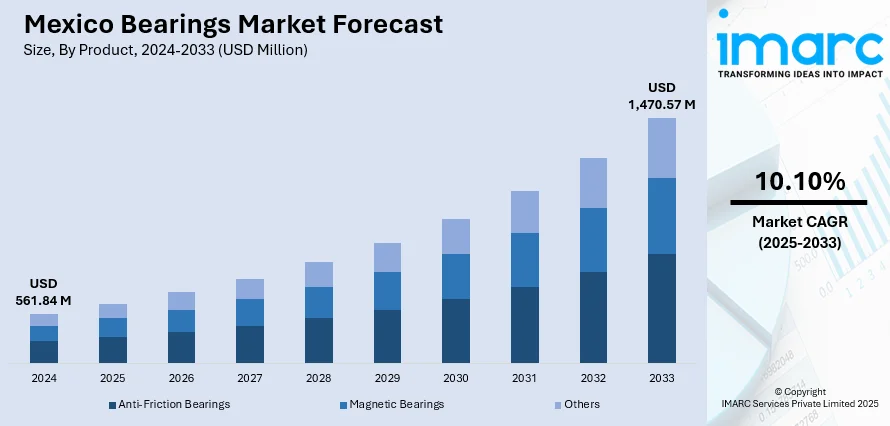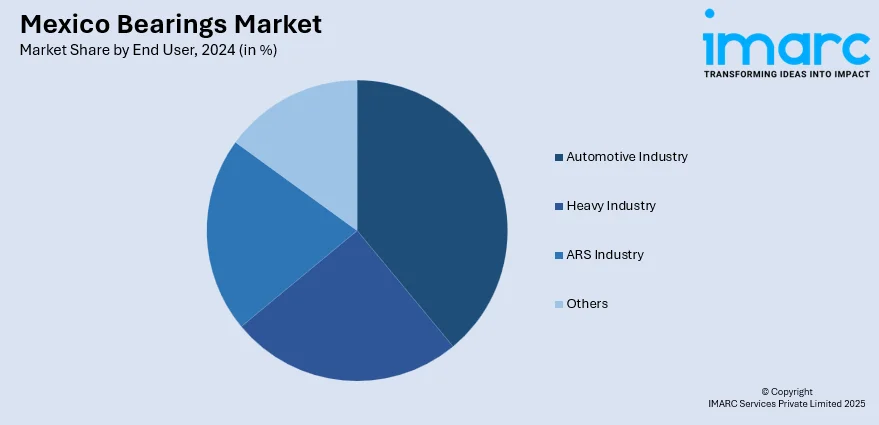
Mexico Bearings Market Size, Share, Trends and Forecast by Product, Type, End User, and Region, 2025-2033
Mexico Bearings Market Overview:
The Mexico bearings market size reached USD 561.84 Million in 2024. Looking forward, IMARC Group expects the market to reach USD 1,470.57 Million by 2033, exhibiting a growth rate (CAGR) of 10.10% during 2025-2033. The market is driven by growth in the automotive and industrial manufacturing industries, aided by increasing vehicle production and machinery requirements. Infrastructure projects such as railway construction and energy facilities are further driving steady demand for high-performance bearings, particularly in heavy-duty equipment. Moreover, increased foreign investments in Mexico's manufacturing centers, favorable trade policies, and North American market access are key factors expanding the Mexico bearings market share.
|
Report Attribute
|
Key Statistics
|
|---|---|
|
Base Year
|
2024 |
|
Forecast Years
|
2025-2033
|
|
Historical Years
|
2019-2024
|
| Market Size in 2024 | USD 561.84 Million |
| Market Forecast in 2033 | USD 1,470.57 Million |
| Market Growth Rate 2025-2033 | 10.10% |
Mexico Bearings Market Analysis:
- Major Drivers: The market is propelled by growing demand for automotive production, industrial equipment, and infrastructure construction. Strategic nearshoring generates foreign investment, boosting demand for dependable bearings hence driving the Mexico bearings market demand. Growing industrial automation and transportation demands further propel the uptake of high-performance bearings in a bid to improve efficiency, longevity, and operational reliability across various industries.
- Key Market Trends: The market is trending towards high-precision and long-duration bearings, especially for electric vehicles and renewable energy machinery. Roller and specialty bearings are becoming increasingly popular due to their capacity to support heavy loads and minimize maintenance. Companies are thinking more about innovation, efficiency, and sustainable manufacturing processes to address changing industrial needs are some of the most important trends in the Mexico bearings market analysis.
- Market Opportunities: Mexico provides significant opportunities in the renewable energy projects, aerospace, and electric vehicle sectors, where specialist bearings are needed. Growing industrial bases and nearshoring initiatives promote regional production and customization. Materials and bearing design technological gains leave scope for innovation to enable firms to differentiate products and make new market niches.
- Market Challenges: The sector is challenged by increased material prices, supply chain disruptions, and issues of counterfeiting. Compliance with regulations and environmental factors introduce complexity along with the Political uncertainties and infrastructure constraints can undermine growth in the Mexico bearings market forecast. Manufacturers have to manage quality, cost, and sustainability while working against competitive pressures and changing customer demands to stay in business.
Mexico Bearings Market Trends:
Rising Automotive Production and Aftermarket Growth
Mexico has become a critical hub in the global automotive supply chain, driving consistent demand for high-precision bearing components in the Mexico bearings market analysis. Notably, in 2024, the country manufactured 3,989,403 light cars, reflecting a 5.6% increase from 2023. This robust OEM activity continues to be a major driver for the market. Bearings are integral in engines, transmissions, wheels, and steering systems. As manufacturers shift towards more fuel-efficient and lighter vehicles, there's a parallel need for advanced, compact bearings with high load capacities. Apart from this, the growth of the automotive aftermarket, spurred by an aging vehicle fleet and rising used car sales, is leading to increased replacement demand. Also, consumers are opting for periodic maintenance to extend vehicle lifespans, sustaining steady purchases of bearings for repairs. Moreover, local bearing suppliers and global players with Mexican operations are enhancing distribution networks to meet this need. Furthermore, Mexico's integration into the US-Mexico-Canada Agreement (USMCA) ensures stable trade conditions and fosters regional manufacturing, enabling just-in-time delivery of bearing components to both domestic and export-oriented automotive manufacturers.

To get more information on this market, Request Sample
Expansion of Renewable Energy and Industrial Machinery Sectors
The diversification of Mexico's energy mix, particularly the expansion of wind and solar energy projects, is contributing to increased demand for specialized bearings capable of handling high-load and high-speed operations in harsh environments. Wind turbines, for instance, require a main shaft, gearbox, and generator bearings that can endure fluctuating stress and rotational speeds. As of 2024, Mexico has over 8 GW of installed wind power capacity, and government incentives are encouraging further development. These projects necessitate long-lasting, corrosion-resistant bearing solutions. As wind farms expand, especially in regions like Oaxaca and Tamaulipas, suppliers are focusing on delivering customized, corrosion-resistant solutions to meet the technical and environmental demands of this sector. Simultaneously, the broader industrial machinery sector, including mining, cement, packaging, and food processing industries, continues to modernize, which is providing a boost to the Mexico bearings market growth. Manufacturers are automating processes, investing in high-performance machinery that depends on precision-engineered bearings to support high-speed shafts, rotary functions, and load-bearing tasks. Additionally, the growth of industrial parks and nearshoring of supply chains is attracting machinery investment, fueling bearing consumption. Market participants are increasingly focusing on hybrid ceramic bearings and condition-monitoring technologies to reduce downtime and improve operational efficiency across industrial applications.
Mexico Bearings Market Segmentation:
IMARC Group provides an analysis of the key trends in each segment of the market, along with forecasts at the country and regional levels for 2025-2033. Our report has categorized the market based on product, type, and end user.
Product Insights:
- Anti-Friction Bearings
- Magnetic Bearings
- Others
The report has provided a detailed breakup and analysis of the market based on the product. This includes anti-friction bearings, magnetic bearings, and others.
Type Insights:
- Ball Bearings
- Roller Bearings
- Plain Bearings
- Others
A detailed breakup and analysis of the market based on the product type have also been provided in the report. This includes ball bearings, roller bearings, plain bearings, and others.
End User Insights:

- Automotive Industry
- Heavy Industry
- ARS Industry
- Others
The report has provided a detailed breakup and analysis of the market based on the end user. This includes automotive industry, heavy industry, ARS industry, and others.
Regional Insights:
- Northern Mexico
- Central Mexico
- Southern Mexico
- Others
The report has also provided a comprehensive analysis of all the major regional markets, which include Northern Mexico, Central Mexico, Southern Mexico and others.
Competitive Landscape:
The market research report has also provided a comprehensive analysis of the competitive landscape. Competitive analysis such as market structure, key player positioning, top winning strategies, competitive dashboard, and company evaluation quadrant has been covered in the report. Also, detailed profiles of all major companies have been provided.
Latest News and Developments:
- In July 2025, CW Bearing USA is advancing its North American strategy through the expansion of its Mexico manufacturing and technology center in Apaseo El Grande, Guanajuato. Since doubling the facility’s size in 2022, the company has focused on installing equipment, enhancing processes, and building capabilities. Phase 2 of the expansion is complete, driving new production and innovation, while Phase 3 is planned, positioning CW Bearing for significant regional growth and increased sales.
Mexico Bearings Market Report Coverage:
| Report Features | Details |
|---|---|
| Base Year of the Analysis | 2024 |
| Historical Period | 2019-2024 |
| Forecast Period | 2025-2033 |
| Units | Million USD |
| Scope of the Report | Exploration of Historical Trends and Market Outlook, Industry Catalysts and Challenges, Segment-Wise Historical and Future Market Assessment:
|
| Products Covered | Anti-Friction Bearings, Magnetic Bearings, Others |
| Types Covered | Ball Bearings, Roller Bearings, Plain Bearings, Others |
| End Users Covered | Automotive Industry, Heavy Industry, ARS Industry, Others |
| Regions Covered | Northern Mexico, Central Mexico, Southern Mexico, Others |
| Customization Scope | 10% Free Customization |
| Post-Sale Analyst Support | 10-12 Weeks |
| Delivery Format | PDF and Excel through Email (We can also provide the editable version of the report in PPT/Word format on special request) |
Key Benefits for Stakeholders:
- IMARC’s industry report offers a comprehensive quantitative analysis of various market segments, historical and current market trends, market forecasts, and dynamics of the Mexico bearings market from 2019-2033.
- The research report provides the latest information on the market drivers, challenges, and opportunities in the Mexico bearings market.
- Porter's five forces analysis assist stakeholders in assessing the impact of new entrants, competitive rivalry, supplier power, buyer power, and the threat of substitution. It helps stakeholders to analyze the level of competition within the Mexico bearings industry and its attractiveness.
- Competitive landscape allows stakeholders to understand their competitive environment and provides an insight into the current positions of key players in the market.
Key Questions Answered in This Report
The bearings market in Mexico was valued at USD 561.84 Million in 2024.
The Mexico bearings market is projected to exhibit a CAGR of 10.10% during 2025-2033, reaching a value of USD 1,470.57 Million by 2033.
Key factors driving Mexico’s bearings market include growth in automotive manufacturing, industrial machinery, and infrastructure projects. Nearshoring and foreign investment boost demand, while increasing industrial automation and renewable energy initiatives require high-performance, durable bearings. Technological advancements and the push for efficiency and reliability further stimulate market expansion across multiple sectors.
Need more help?
- Speak to our experienced analysts for insights on the current market scenarios.
- Include additional segments and countries to customize the report as per your requirement.
- Gain an unparalleled competitive advantage in your domain by understanding how to utilize the report and positively impacting your operations and revenue.
- For further assistance, please connect with our analysts.
 Request Customization
Request Customization
 Speak to an Analyst
Speak to an Analyst
 Request Brochure
Request Brochure
 Inquire Before Buying
Inquire Before Buying




.webp)




.webp)












